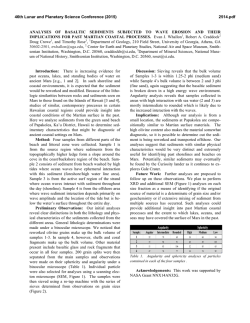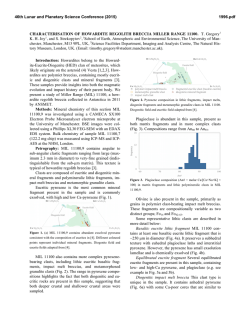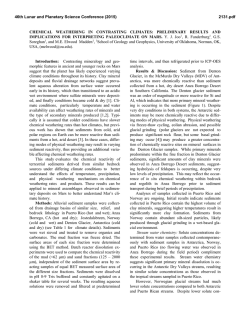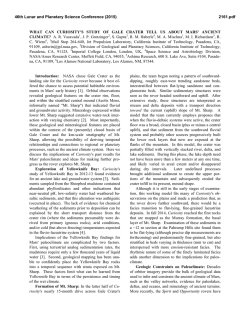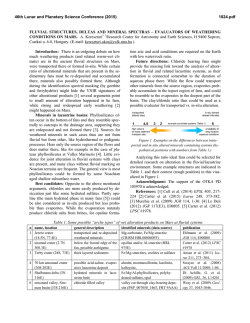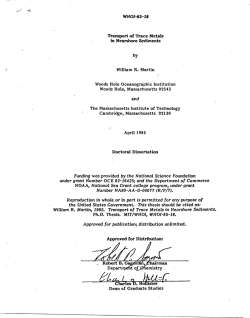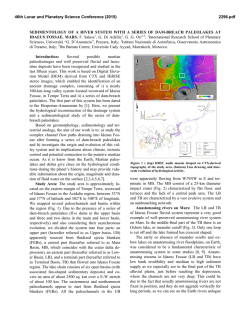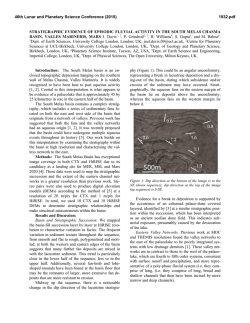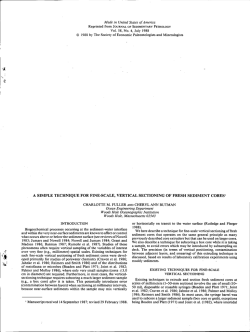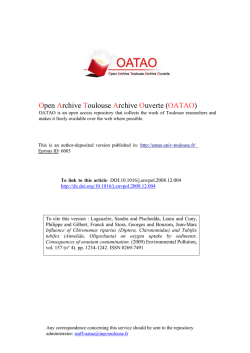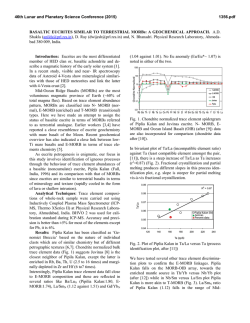
Characteristics of Basaltic Particles Transported by Different
46th Lunar and Planetary Science Conference (2015) 1475.pdf CHARACTERISTICS OF BASALTIC PARTICLES TRANSPORTED BY DIFFERENT GEOLOGIC PROCESSES. Robert A. Craddock1 and Timothy Rose2, 1Center for Earth and Planetary Studies, National Air and Space Museum, Smithsonian Institution, Washington, D.C. 20560, [email protected], 2Department of Mineral Sciences, National Museum of National History, Smithsonian Institution, Washington, D.C. 20560, [email protected]. Introduction: The chemical and physical characteristics of sedimentary material can provide valuable clues about transport processes, distance traveled, and provenance. For example, it is possible to distinguish the emplacement process of sediments based entirely on the shape of the quartz grains in the deposit. These traditional sedimentological concepts have been applied to our interpretation of surface materials on other planets; however, our current understanding of these concepts is based on sediments derived from the terrestrial continental crust, which is typically felsic (e.g., granite) in composition. In contrast, the surfaces of the terrestrial planets are composed primarily of mafic material--basalt--which generates much different sedimentary particles as it weathers. Instead of quartz, feldspar, and heavy minerals commonly found in most terrestrial sedimentary deposits, basaltic sediments are composed of varying amounts of olivine, pyroxene, felspar, and vitric and lithic fragments. Both the durability and specific gravities of particles derived from basalt are different from particles derived from granite. Because of their chemical composition and crystalline structure, it is anticipated that basaltic sediments will also weather much differently than felsic materials. Our study will document the physical and chemical changes that take place in basaltic sediments as they are transported by wind, water, and ice over increasing distances. This will result in an improvement in our understanding of traditional sedimentological concepts when applying them to the surface materials on other planets, particularly Mars but Venus as well. Sediment Provenance: Here we present preliminary analyses of the physical characteristics of basaltic lithic fragments found in volcanic tephra, eolian dunes, fluvial deposits, and glacial moraines on the Big Island of Hawaii. Lithic fragments can be particularly important for characterizing basaltic sediments because unlike olivine or vitric fragments, they always account for some size fraction of the deposit. Lithic fragments have also been found in many of the surficial deposits analyzed on Mars [e.g., 1, 2]. Aeolian sediments. There are only a few places on Earth where dunes composed of basaltic sediments have been documented, including the Ka‘ū Desert in Hawaii [3]. The Ka‘ū Desert is ~350 km2 in size and contains one of the largest basaltic dune fields on Earth. The source of basaltic materials comes from periodic phreatic eruptions that Kīlauea has experienced over the last 2,000 years [4]. Collectively mate- rial from these eruptions has created the Keanakāko‘i Tephra deposit. This tephra was deposited in a series of eruptions that were close to the same scale and intensity each time [5]. Therefore, the assumption that we make is that the Keanakāko‘i Tephra is the local source for all the dune material. The continuous Keanakāko‘i Tephra is located in an ~3-km swath around Kilauea’s central caldera, and transport distances can exceed 12-14 km. We have identified and collected samples from several different dune types located in various parts of the desert, including climbing and falling dunes, sand sheets, parabolic dunes (that were initially barchans), and crescentic dunes. Fluvial sediments. Fluvial sediments are located in a series of gullies and channels that have incised the Keanakāko‘i Tephra deposit [6]. Where the tephra becomes more patchy and discontinuous, fluvial flow goes from confined to unconfined, resulting in a series of floodout deposits and playas in an area we refer to as the Ka‘ū Lava Ramp. Although there is evidence for some aqueous flow in other parts of the desert, we have collected fluvial sediments in the drainage networks that have incised the Keanakāko‘i Tephra where the source is obvious. Some additional, select samples from fluvial features (e.g., bedrock channel and small playas) within the Ka‘ū Lava Ramp have also been collected to check for physical and chemical changes that may have occurred with longer transport distances. Glacial sediments. Mauna Kea is the only volcano in Hawai’i with unequivocal evidence of Pleistocene glaciation [7]. Drift deposits associated with at least three distinct episodes of glaciation have been identified [8]. The Makanaka Glacial Member is the youngest known glacial unit on Mauna Kea, and because it superposes the other glacial deposits, it is also the most readily accessible. This unit is present as end moraines, lateral moraines and ground moraine that form a nearly continuous annulus between ~3400 and 3800 m, and delimit an ~10-km-diameter ice cap [7 and 8]. Makanaka glaciation has a complicated history, but cosmogenic 36Cl dating of terminal moraines and other glacial landforms indicates that the last two ice caps, called Older Makanaka and Younger Makanaka, retreated from their maximum positions approximately 23ka and 13ka, respectively [9]. (Cosmogenic 3He dating suggests that glacial retreat began closer to 20.5ka and 14.6ka [10].) We have collected surface 46th Lunar and Planetary Science Conference (2015) samples of the Makanaka Glacial Member from accessible areas on the summit of Mauna Kea. A valid analog. A challenge faced by all analog studies is the onus of placing the observations and interpretation we make here on Earth into context with those we see on other planets. Essentially, the samples we are analyzing need to be placed into context with lithology and environment (i.e., climate). Detailed analyses of rock and sediments from the Mars Exploration Rovers [11] and the Curiosity lander [12] indicate that Hawaiian volcanic materials are ideal Martian lithologic analogs. The simplest thing to be said about the environmental differences is that we understand them, and secondary alteration of the samples we have collected due to the environment is negligible. For example, laboratory analyses by [13] indicate that the Keanakāko‘i Tephra is generally “little altered.” Analyses by [14] and [15] agree that the “degree of weathering (of the Keanakāko‘i Tephra) is volumetrically small.” In fact, the alteration products from Hawaiian materials have been important for characterizing Martian surface materials, such as the phyllosilicates [16]. Observations: We conducted analyses of the the lithic fragment samples using an optical microscope and a scanning electron microscope (SEM). The optical microscope was used to characterize the particle sorting of the deposits and to identify and select representative lithic particles for analyses by the SEM. There are several surprising observations that may have important implications for determining the provenance of basaltic materials on the terrestrial planets. For example, lithic fragments free of vesicles typically display an initially rough surface texture (Figure 1). 1475.pdf cesses. Such polishing of particle surface textures is generally more often seen in felsic sediments transported by fluvial processes. Figure 2. Lithic fragment collected from fluvial deposits in Sand Wash [6]. Figure 3. Lithic fragment transported by aeolian processes. Figure 1. Lithic fragments from the Keanakāko‘i Tephra. Figure 2 show that this surface texture is preserved after the particles have been transported by fluvial processes (albeit over distances of only a few kilometers). This surface texture becomes less common in lithic particles that have been transported by aeolian pro- References: [1] Cabrol N. A., et al. (2014) JGR, 119, 941–967. [2] Sullivan R. et al. (2008) JGR, 113, E06S07. [3] Gooding, J.L. (1982) Jour. Geology, 90, 97-108. [4] Fiske, R.S. et al. (2009) Geo. Soc. Amer. Bull., 121, 712–728. [5] McPhie, J. et al. (1990) Bull. Volcanol., 52, 334-354. [6] Craddock, R.A. et al. (2012) JGR, 117, E08009. [7] Porter, S.C. (1979) Quaternary Research, 12, 161-187. [8] Porter, S.C. (2005) Quaternary International, 138-139, 118-128. [9] Pigati, J.S. et al. (2008) Jour. Quaternary Sci., 23, 683–702. [10] Anslow, F.S. et al. (2010) Earth Planet. Sci. Letts., 297, 234-248. [11] Gellert, R. et al. (2004) Science, 305, 829832. [12] Brown, D., G. Webster, and R. Hoover (2012), NASA Press Release 12-383. [13] Hay, R.L., and B.F. Jones (1972) Geol. Soc. Amer. Bull., 83, 317-332. [14] Schiffman, P., et al. (2000) Geochem. Geophys. Geosyst., 1, Paper number 2000GC000068. [15] Schiffman, P. et al. (2002) Geological Society, London, Special Publications, 202, 393-405. [16] Bishop, J.L. et al. (2008) Science, 321, 830-833.
© Copyright 2026
